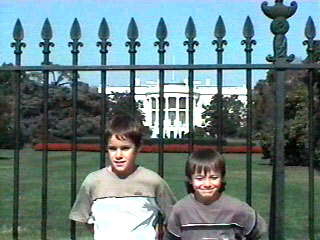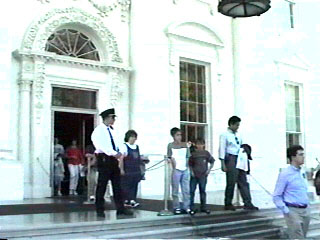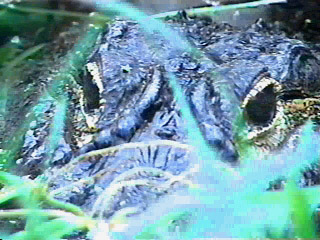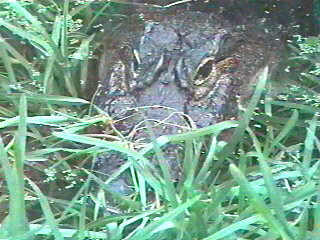Washington D.C.
October, 2000
But first a stop in Connecticut
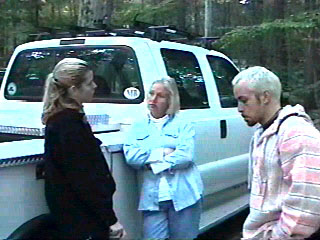
Margaret Cheryl
Robert
|
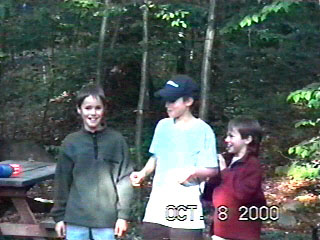
Mitch Patrick
Max
|
Here's a picture of some friends we met in San
Diego last winter. Since we were there for three months, Mitch
and Max became good friends with their son, Patrick.
They have moved back to Connecticut, their home state, for the summer.
We hope to see them again this winter in Florida.
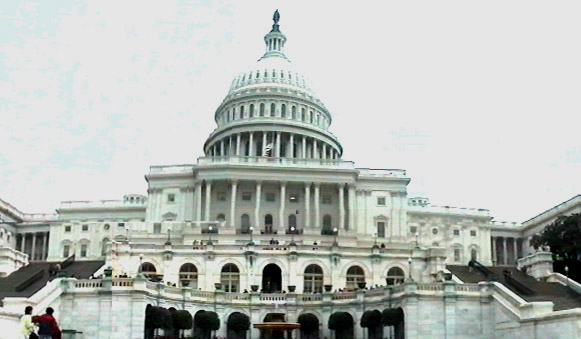
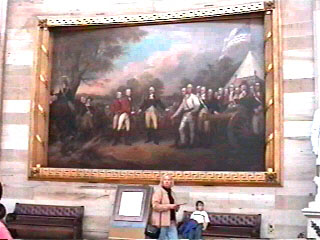 |
Washington D.C. is another city that we could write about
for days. We were there for a week and saw less than half of the
places we would like to have visited. The main entry into the Capitol
Building opens into the Rotunda, the room under the dome. The architecture
of the Rotunda is very impressive. The walls are filled with paintings
that tell the story of early America. |
We obtained Senate passes from Senator Patty Murray's office
and watched a Senate session for a while. We visited the House of
Representatives, but they were not in session until later that afternoon.
Other stops we made near the Capitol Building was the Library of Congress
and the Supreme Court. Like most of the buildings here, the granite,
sandstone, marble, and architecture of the buildings are a site to see.
The softer marble steps in the Capitol building are so worn that they slope
and have dips in each step tread along the main walking area.
At the Capitol Building Mitch and Max learned about the
legislative branch of American government and at the Supreme Court they
learned about the judicial branch. At the Supreme Court we saw a
display showing other countries that have established democratic governments
similar to ours. Some date back to the early 1800's and the most
recent was just two or three years ago. (I think it was Kenya, but
don't quote me on it.) Only one more branch to visit, the Executive
branch.
We didn't get to meet Bill Clinton, but we did get a couple
of chances to see Buddy, his dog. I thought the a picture of the
boys in front of the White House should be without the fence. So
I told them to jump over and I'd hold the camera through the bars.
I figured if they were quick we could scoot away before security arrived.
Well I got the picture . . . . .
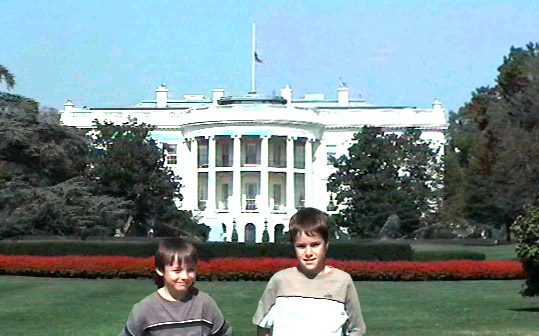
But guess what?
I actually used software to create this effect.
To visit the White House we were in a line that was about 1/4 mile long.
It moved quickly however. As we walked the boys kept looking for
security cameras and motion detectors. They wondered how long it
would take for security to arrive if they jumped the fence, but I was wondering
how long it would be before we'd see them again afterwards.
We also met a mom and her daughter in line that we had
chatted with earlier that morning while waiting for a light to change.
None of us were sure whether we wanted to wait in this very long line.
But when we saw each other at the end of the line, it was as if we were
there with friends. We talked the whole time in the line. It
turns out that Lindsay, the daughter, has asked to switch from the public
school system to home based schooling. She even went as far as outlining
all of the pros and cons and explaining in a letter how it could be accomplished.
So we talked quite a bit about Mitch and Max's schooling experiences and
what we had learned from the Home School Conference last year and all of
the books we have read on the subject. We'll have to stop by next
time we get to their town and visit them and their horses; (Max really
like horses).
The Smithsonian Institute
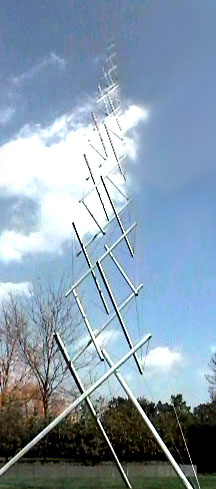 |
The Smithsonian Institute is a complex of 16 museums,
galleries and the National Zoo. The Smithsonian holds more than 140,000,000
artifacts and specimens. The Original Smithsonian Building will be
seen later on this page. The Smithsonian was established in 1846
with funds bequeathed to the United States by the English Scientist, James
Smithson, "for the increase and diffusion of knowledge." He chose
Washington D.C. because it represented a place where the freedom for knowledge
could flourish.
First we stopped by the Smithsonian Visitor Center for
information and an orientation video. Max wanted to go see the Wright
brother's plane so we headed to the Aerospace Museum. Along the way
we stopped by the museum of Arts and Industry and the Hirshhorn Museum
and Sculpture Garden.
This structure is standing in the Sculpture Garden. |
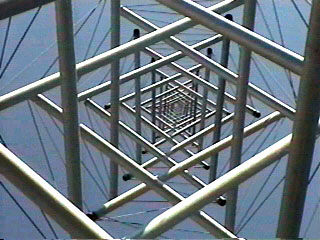 |
This is a picture taken from the center of the structure
looking up through the middle. |
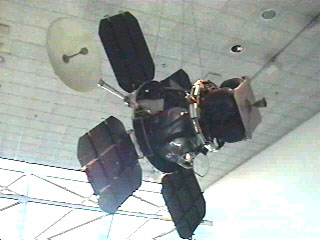 |
We arrive at the Aerospace museum and found that we were
just in time for a guided tour. Although there were hundreds of people
visiting the museum, we were joined by only one other couple visiting from
Australia. We prefer to see orientation films and participate in
guided tours when available. Only once or twice we've come across
a real boring one. The guides usually provide expert or interesting stories
we wouldn't get by ourselves. |
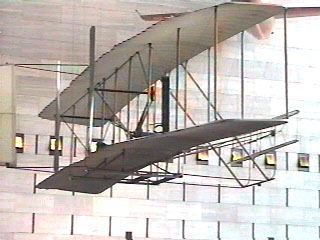 |
The picture above is a backup Lunar Orbitor craft.
I found it interesting since my dad worked on the program with Boeing Aerospace.
This is a picture of the actual Wright brothers plane.
Most of the exhibits at the Smithsonian are the real thing -- not replicas. |
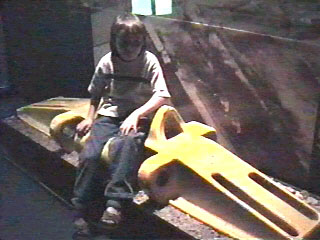 |
Max couldn't pass up a picture sitting on this piece
of track from the module used to move the space shuttle and other rockets
to the launch pad at Cape Kennedy. |
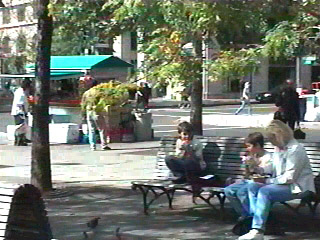 |
As we travel we like to try the local restaurants and
breweries. However, the boys much preferred a bench and a Polish
sausage from one of the street vendors which are prolific around town. |
This lunch was right after we saw the original "Declaration
of Independence" and other documents in the National Archives.
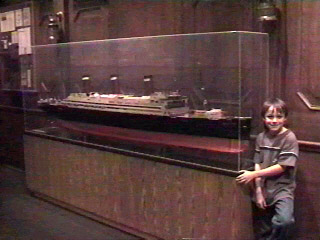 |
Our next stop was the American History Museum.
Hey Grandpa, (Cheryl's dad), you said you would make a model of the Titanic.
Will it look like this one? This isn't the Titanic but it's one of
many, many impressive model ships and boats in the Maritime wing of the
museum.
|
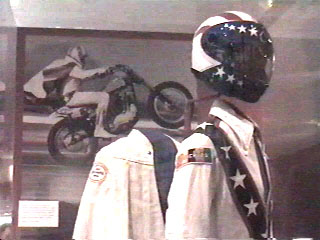 |
We expected to see lots of the older collections in the
American History Museum. But we also saw Evil Knevil's suit and motorcycle. |
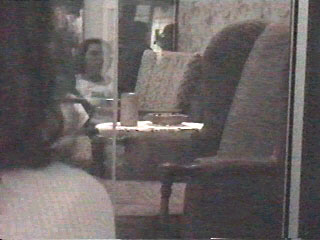 |
Archie Bunker's chair, yes the real live actual chair,
and also Mr. Rogers' red, zip-up sweater.
So I don't know what this says about American History
-- to have Archie's chair as a prized artifact, or worse yet, what it says
about me for highlighting it on this web page. |
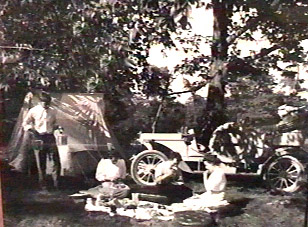 |
Here's a photo of "Autogypsies." What's an autogypsy
you ask? Read on, here's what the plaque said. |
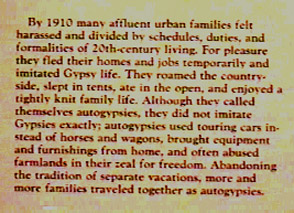 |
By 1910 many affluent urban families felt harassed and
divided by schedules, duties, and formalities of the 20th-century living.
For pleasure they fled their homes and jobs temporarily and imitated Gypsy
life. They roamed the countryside, slept in tents, ate in the open,
and enjoyed tightly knit family life. Although they called themselves
autogypsies, they did not imitate Gypsies exactly; autogypsies used touring
cars instead of horses and wagons, brought equipment and furnishings from
home and often abused farmlands in their zeal for freedom. Abandoning
the tradition of separate vacations, more and more families traveled together
as autogypsies. |
Do you know any autogypsies? I think we have met a
few hundred.
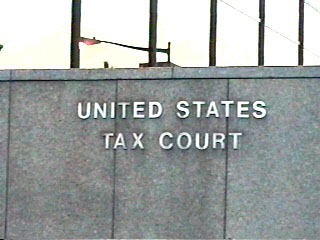 |
Parking outside of this building was about as close as
we wanted to get. We did however go into the building of the Department
of Labor and Industry. Since we process OSHA regulations as part of Cheryl's
business it seemed appropriate. After clearing the security check we were
surprised to find some very interesting displays. We saw displays
on the history of organized labor in the U.S., the rise of labor laws in
general, laws to protect field workers and children, pictures and stories
of past department heads and key people who brought about major changes
to labor and safety in the workplace. |
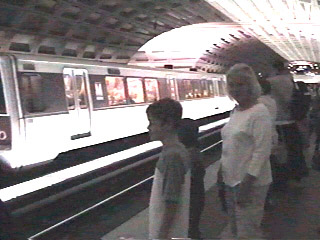 |
This was the nicest subway system we've seen so far --
clean, large, convenient and fast; real fast. Parking is difficult
here. There's plenty of parking at Union Station and from there we
could catch the subway into town. These trains are fast and long.
The subway tunnels are smaller than the station. So when standing
near the opening and a subway approaches at high speed it pushes a lot
of air creating a blast of wind. Then the 100 yard long train comes
flying by at high speed. Since it is so long, the front is still
traveling at full speed as it passes. By time the end clears the
tunnel, the train has stopped. |
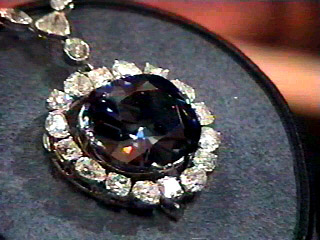 |
The Natural History Museum has the Hope Diamond
as well as collections of bugs, rocks, animals and other natural artifacts
and specimens. |
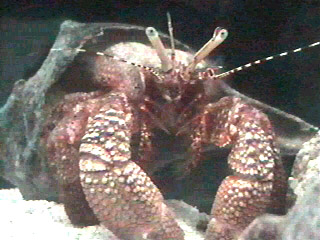
Hello
(A crab in the Natural History Museum)
|
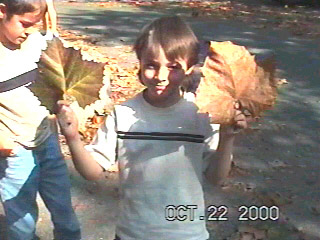
Max was impressed with the size of these leaves
|
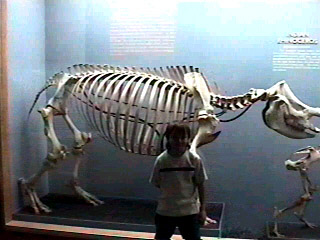 |
We've seen many displays of stuffed animals in our travels.
Here we found a great display of skeletons. They were grouped by
category with explanation of the similarities and differences. Max
is standing in front of a rhinoceros. |
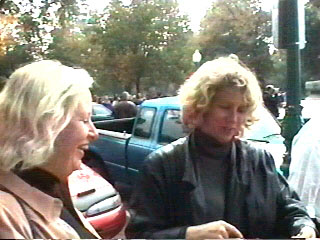 |
We were in town for a week and saw several sites each
day. Here we are waiting in line to get into the Capitol Building
as Cheryl talks with a lady from California. She has been assigned
as her company's network administrator and flew to Washington DC for some
training. She has four hours before her plane leaves and wants to
see some sites.
A lot of people ask us if we still like traveling.
The answer is yes. |
The difference is that we are not in a hurry like this gal
or a family on a two week vacation. We do get a little burned out
after an intense week in a town like Washington D.C. So then, we'll
just head off to a nice place out of town and slow down for a few days.
So it's not like being in a continuous "vacation mode." We have been
seeing lots of sights since we left San Diego last April. By the
time we get back from Europe we'll be ready to do so heavy duty relaxing.
Maybe take a vacation from traveling for a few weeks.
Mitch and Max have a term for this, they call it "stay
home days." They like stay home days.
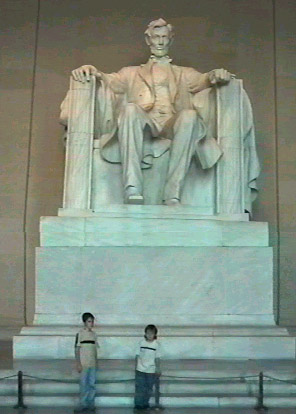
The Lincoln Memorial
|
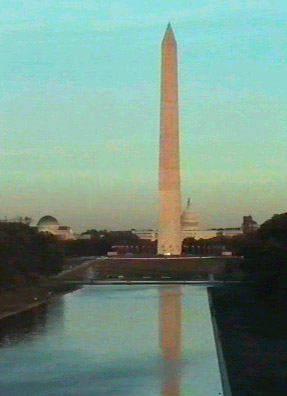
The Washington Monument
|
The boys recognized this place as the scene where Forrest
Gump and Jenny see each other and run through the reflecting pond into
each others arms. (From the movie Forrest Gump)
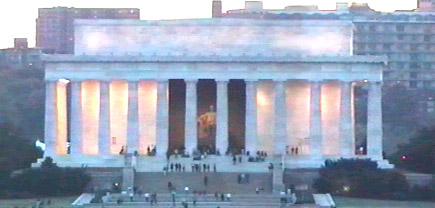 |
This picture was taken near sunset as the building lights
began to show.
It's often hard to get a good picture with our video camera
due to the bright sky in the background. But that's where the zoom
lens helps out. This picture was taken from the Washington Monument.
As the lens zooms in, the intensity from the sky is decreased and the main
objects stand out much better. |
We touched briefly on the significance of Abraham Lincoln,
but our focus with the boys has been on Revolutionary American history
on this trip east. We'll have to come back for a lesson on Civil
War history.
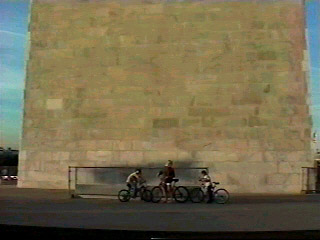 |
The Bunker Hill Monument in Boston
is a similar obelisk to the Washington Monument. Bunker Hill has
294 steps to the top and seemed quite large. But when I saw the Washington
Monument I could not believe the size. The base is two or three times
the length on each side and it's much taller, about 900 steps. The
stairway was closed for renovation and with only a week in town we decided
to pass on the ticket cost and yet another line for an elevator ride to
the top. |
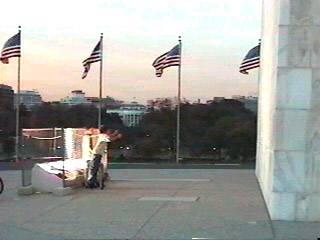 |
The Washington Monument is lit at night by many halogen
lights. We drove by the first night we were in town and Mitch wanted
to stop and make hand-animal shadows in the lights on the Memorial's wall.
So later in week we stopped by and the kids made shadows on the walls. |
|
The Washington Monument and the Smithsonian Castle
at sunset.
We took our bikes to town one day. It worked out
real well. We parked at Union Station and road three blocks to the
Capitol Building. From there we could ride on the National Mall all
the way to the Lincoln Memorial. |
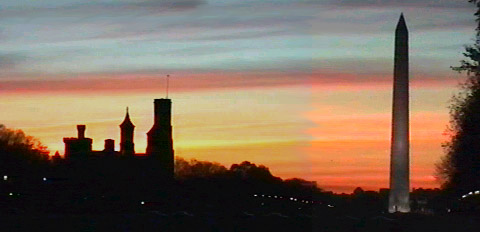 |
The National Mall is the two block wide two mile long strip
of grass and trees between these two locations. Nine of the Smithsonian
Buildings are on the Mall as well as many of the Government ones.
A bike is a good way to get around. The Castle is the original Smithsonian
building.
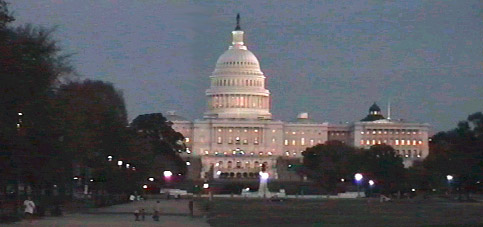 |
The Capitol Building at night. The only difficulty
of riding bikes was stopping to take pictures every few minutes.
As the sun started to set the whole area took on a new appearance. |
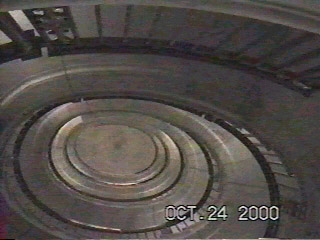 |
Here's a unique picture I thought I'd throw in.
(You're looking from the third floor up to the top). It is one of
the two self-supporting elliptical stairways inside of the Supreme Court
Building. We weren't allowed to go to the bottom, two floors down,
to get a good centered picture of all nine spirals. |
The National Zoo
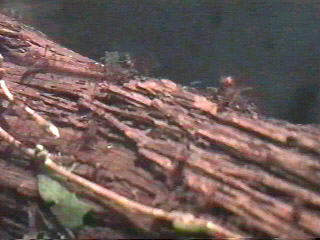 |
The most interesting display for us at the Zoo was the
ants. These little critters were cutting and packing leaf sections.
There were several glass enclosures connected to each other with clear
tubes like hamster tracks. Each day new branches with leaves are
placed inside for the ants. |
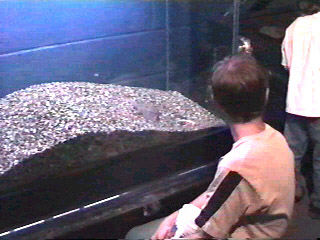 |
The next enclosure had a large pile of cut leaf parts.
We thought this was a stock pile. We asked about this and learned
it was actually a waste pile. The ants eat a fungus that grow on
the leaves. |
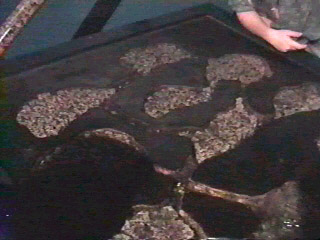 |
The third area, seen here, is where they take the leaves
to grow the fungus. If a leaf does not promote the growth of the
fungus it is returned to the waste pile and new leaves are brought in.
A fourth area is an old colony that has been abandoned and is now a place
where they put the dead ants. |
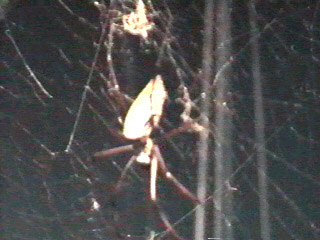 |
We also saw an open display of these silver dollar sized
spiders. No glass, no screen, no enclosure, just a few dozen
large spiders with very large webs hanging around in the corner.
They like to stay put, so other then spreading out a little into the heater
ducts and conduit, they don't go too far. |
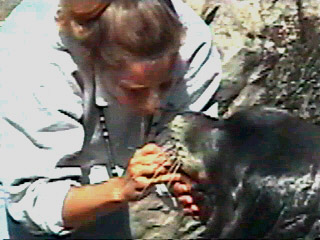 |
The daily seal show is a combination show and medical
checkup. Each day the seal holds still for a brushing and pick cleaning
of one or two teeth. Also, as part of the routine is a mock injection.
No needle is used but the trainer pinches a little as the seal lies down
for a shot. This way when a real injection is required the seal just
thinks it is part of the daily show. |
The only difference between me and "The Crocodile
Hunter" is a one inch thick piece of glass.
| Another favorite was the Cheetah. This animal has
a twenty four foot stride during a full run. |
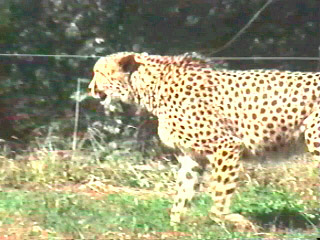 |
ã
copyright Nodland 1999-2020






